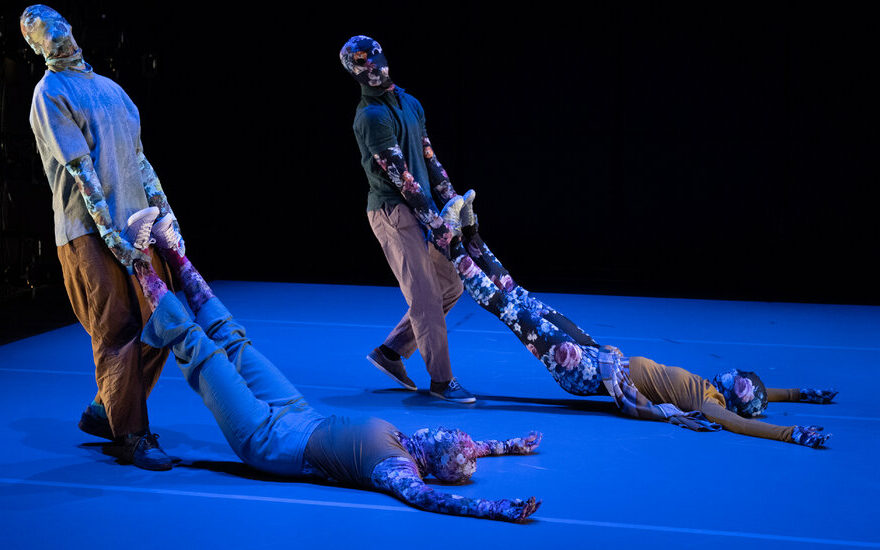Some dances emerge from a choreographer’s own obsessions, and others, like Liz Roche’s “Yes and Yes,” from an external prompt. For the centenary of James Joyce’s “Ulysses,” which was first published in full in 1922, the arts organization Solas Nua invited Roche, one of Ireland’s leading contemporary dance artists, to respond to the modernist novel through dance.
This had to be a daunting task, but “Yes and Yes,” which had its New York premiere at the Irish Arts Center on Thursday, betrays no signs of trepidation. It’s a fluent expression of Roche’s lush and lyrical sensibility. She and her team, including the cast of four excellent dancers, have distilled the famously convoluted text into a poetic, beautifully wrought 70 minutes. In its relative orderliness and palatability, “Yes and Yes” is not really a danced analogy to the book, but something else, complex in its own ways, true to Roche’s voice as she converses with another.
As the audience enters the theater, scene-setting words run across a wide rectangular screen at the back of the stage: “Sound of fans and gulls, traffic and sea.” It’s enough to let us know we’re in Dublin, an impression augmented, once the work begins in earnest, by a rendering of those sounds and projections of urban structures against a morning sky. (Ray Harman is credited with the music, which can be subtle or sweepingly dramatic, and José Miguel Jiménez with the film and visuals.)
A lone dancer (the compelling Sarah Cerneaux) enters the empty space and delivers a matter-of-fact movement phrase, woven with gestures that could be plucked from physical descriptions in the text. She freezes like an orator interrupted mid-speech; crouches with her fists raised like a boxer’s; shakes her head as if freeing something from her ear. As she begins to walk repeatedly in a circle — soon joined by Mufutau Yusuf, Grace Cuny and Toon Theunissen, who match the steady rhythm of her footfalls — you sense that the day has begun.
Like the book, the dance proceeds as a series of episodes. Roche seems to have selected a handful of Joyce’s 18 sections, interpreting some more literally than others, and establishing certain gestural motifs that lend a sense of cohesion. Perhaps the most recurrent and laden with meaning — at times a bit too heavily — is a hand at the heart, cupped or with fingers blooming upward, paired with pulsations of the chest.
In one episode, Yusuf walks onstage and pulls a synthetic heart from under his shirt, offering it to the angelic Cuny. Roche is judicious in her choice of when to supply language, and how much. The following passage is one of just a few that appear projected on the screen:
“Broken heart. A pump after all, pumping thousands of gallons of blood every day. One fine day it gets bunged up: and there you are. Lots of them lying around here: lungs, hearts, livers. Old rusty pumps: damn the thing else. The resurrection and the life.”
In the vigorous dancing that follows — under Davison Scandrett’s deep red lighting, and backed by a slow cascade of religious images — the performers could be a pumping heart themselves, four chambers that begin in harmony and ultimately fracture, until only Yusuf is left, lying face down on the floor. (Cerneaux returns for something like a grieving ritual, maybe a resurrection.) At other times, the dancers pat their torsos, as if trying to locate their internal organs.
Given Roche’s artistic medium, the body, it makes sense that she would lean into this corporeal imagery. From a source known for its alienating qualities, she wrings feeling and humanity. She also embraces themes of eroticism, especially in the climactic penultimate episode, when all of the dancers, anonymized in floral-patterned body suits and face coverings, entangle in lustful and violent poses. (Katie Davenport did the costume and stage design.) There’s humor here, too, the interactions goofier than they are gritty.
“Yes and Yes” could use a bit more grit. But in flashes, it grazes genuinely disturbing territory. The work takes its title from the last lines of “Ulysses,” in which Molly Bloom recalls an ecstatic sexual experience. In the final episode of the dance, Cerneaux jostles in various suggestive positions, with an energy that looks more clinical than pleasurable. Her closing gesture is to glance over her shoulder at the audience, then push her face away from us. It’s almost a “no.”
“Yes and Yes”
Through Saturday at Irish Arts Center, Manhattan; irishartscenter.org.
Source: Read Full Article
